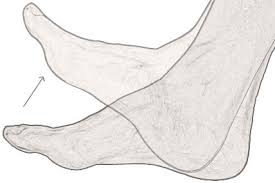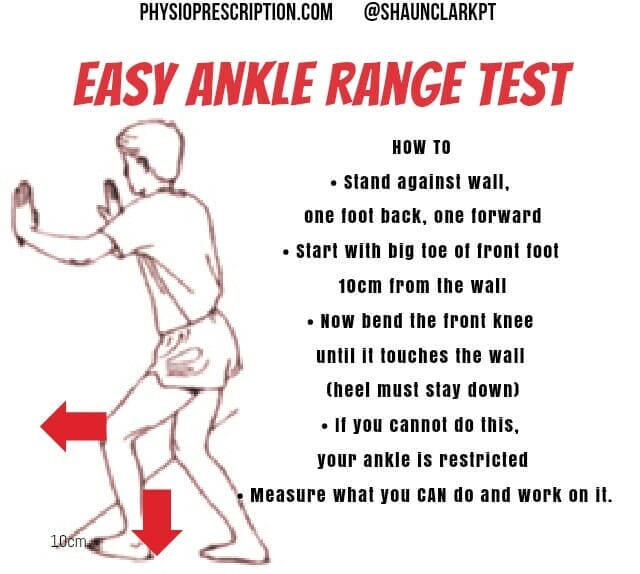
There are very few tests which are proven predictors of injury AND are accurate on anyone. If you want to go straight to the ankle range test – skip down the page to The Test infographic.
Why is a good ankle range of motion (ROM) important?
Limited ankle range – namely ankle dorsiflexion, which is where your foot bends up towards your shin, like at the bottom of a squat – affects many of our everyday movements and activities, such as squats, climbing down stairs, landing from and jump and even walking.
Having a limited ankle range of motion (ROM) can and will lead to injury.
After a “battery” of musculoskeletal tests, this study found that only ankle dorsiflexion range of movement, measured using the weight-bearing lunge test (what I am showing you today), was significantly associated with sustaining a lower extremity injury.
Just a few of these injuries are:
- “Shin splints” – Stress fracture of the shin or medial tibial stress syndrome
- Plantar fasciitis
- Knee pain
- Achilles tendinopathy
How does a stiff ankle contribute to injury?
Having one part of the kinetic chain limited, means that other parts (e.g. plantar fascia, hip flexors) need to absorb this lack of flexibility.
It could also mean you start doing things differently – compensatory patterns, to ignore this problem.
It’s unlikely that you would even realize that this is occurring – which is why doing this test regularly is so important!
Having limited ankle dorsiflexion has even been shown to be a real risk factor ankle sprains – Which, as we know, are VERY common.
Overloads other structures
- Plantar Fascia – Simply due to the heel coming off the ground early – putting earlier and greater stretch on the tissue on the bottom of the foot
- Knees – Due to hyper-extension and over-pronation of the foot
- Hips – The hips can actually really affect the ankle, so it works both ways
Compensatory movements
- Early heel lift (1)
- Excessive pronation
- Knee hyperextension
So what is this all-powerful test?
The all-powerful ankle range of motion test
As mentioned above, this test is something special.
It easily shows whether you are at risk of lower limb injury.
It is very reliable and accurate, even when done by novices, AND it is one of the most common tests used in Physiotherapy.
The standing lunge test – Also know as the knee-to-wall test – Is demonstrated in the image below:

Note: if you are naturally a very flexible person, you should be aiming for 15cm (6 inches).
Read this post for more information about stiff ankle, why it is stiff and how to fix it. Also visit this post to see a comprehensive rehab guide for sprained ankle.
Final Thoughts
You cannot go wrong with this test as it is very reliable, standardized and easy to test, and then re-test down the track after you have been working on it!

